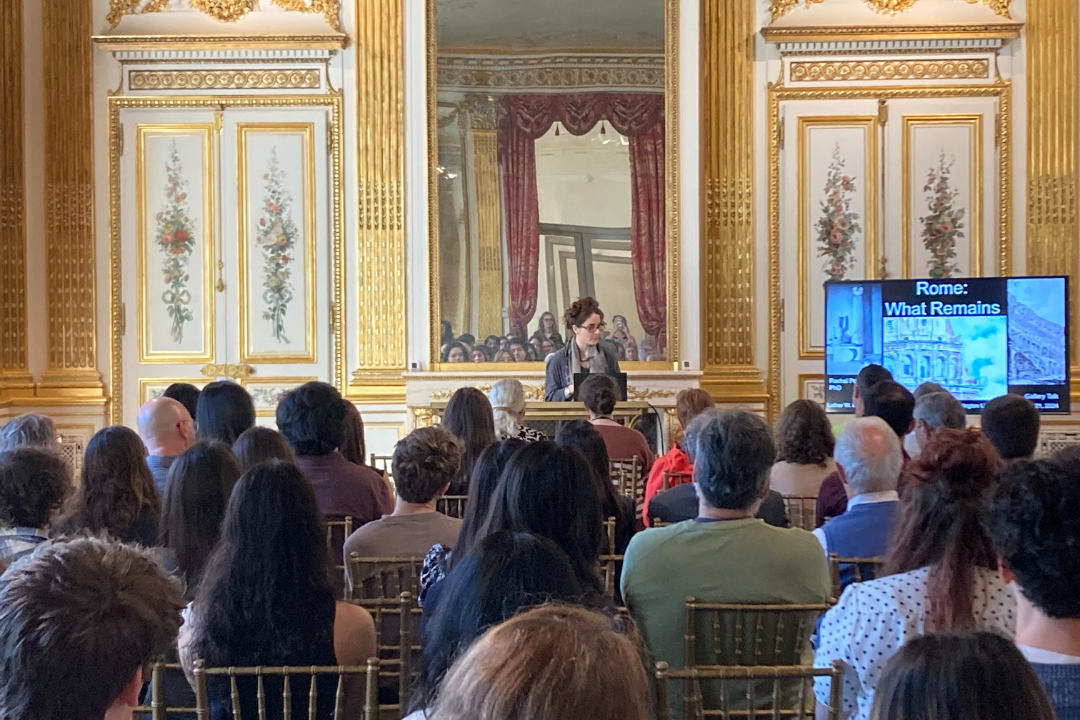By: Alexa Brown
Bathed in the soft hues of dawn and dusk, Rome’s timeless beauty came alive through contemporary artists and alumni from the GW community. On Monday, October 21st, this was the sentiment by the nearly ninety people in attendance for the opening reception of Rome Now, the Pop-Up Exhibition inspired by the current show at the Luther W. Brady Art Gallery, Piranesi’s Rome: Views of the Eternal City. Delicate washes of watercolor, deft strokes of oil paint, and even the subtle shades of charcoal and a carefully crafted Roman-inspired mosaic–all captured the minds and imaginations of visitors to the gallery.

This Pop-Up Exhibition, which was briefly on view from October 9th to the 26th, was curated by Dr. Rachel Pollack and Olivia Kohler-Maga, the Assistant Director of the Luther W. Brady Art Gallery, along with Katherine Capristo, a recent graduate of GW’s Art History BA Program (2023). The show was a way to encourage viewers to revisit the exhibition Piranesi’s Rome: Views of the Eternal City, curated by students from Dr. Pollack’s summer 2024 WID: Discovering the Romans, and other current students and recent GW alumna. This innovative WID offered students a journey through the ancient Roman world by exploring its profound influence on Western art and architecture from the Renaissance to the present day. The Pop-Up literally brought viewers to now. This was an occasion where a writing course served as the impetus for an exhibition and a reminder of how the GW community came together in the name of art.

At the opening reception, attendees gathered in the Salon Doré, a space reminiscent of Versailles, to prepare for Dr. Rachel Pollack’s talk titled "Rome—What Remains." The Gallery buzzed with visitors in anticipation. Pollack introduced both shows, Piranesi’s Rome and Rome Now, and explained how Piranesi’s art and Rome brought together the GW community. Dr. Pollack, herself an artist, included in the exhibition a selection of recent watercolors she painted of Rome both directly and indirectly inspired by Piranesi. Even those not interested in art history found her talk witty and engaging. Dr. Pollack drew from her firsthand experiences on her many trips to Rome, metaphorically bringing the historical destination to Washington, D.C.. This talk informed listeners all about Piranesi’s life and its relation to Roman art and architecture. A key highlight from the event was her story about how she painted one of the artworks featured in the show. She worked swiftly at dusk, capturing the bright orange and yellow shadows beneath the arches in "Aqueducts at Dusk," which beautifully showcased the setting sun and immersed the observer in Professor Pollack’s experience in Rome.

This exhibition also transported visitors to Rome and provided an immersive experience. One standout piece was GW Tempietto by Heather Herbstritt, a recent GW Class of 2022 alumna from the Art History Program's BA/MA Degree. This work depicts an architectural element located just outside the Gelman Library. Many of us pass by it every day without giving it a second thought. Herbstritt’s piece emphasizes how modern designs often draw inspiration from Roman antiquity, prompting a realization that countless aspects of our everyday lives reflect the past in some manner. Other notable pieces present at the event that stood out to viewers were Capitoline Hill (1985) by Marc Schneiderman and impressive Italian Architectural Still-Life (1981) by Janis Goodman.


Roman art and its legacy can be experienced beyond the confines of traditional museum settings. This exhibition also owes its existence to the insights of numerous GW students and alumni who traveled to Rome and generously shared their immersive experiences, whether through study abroad programs or personal journeys. On one of the screens in the gallery, visitors could actually see and read personal testimonies from across generations.
Katelin Fallon, who began her undergraduate studies at GW in 2004, advised, “Don’t just stay in the city center, go to Ostia to see the sites and swim in the sea. Go to Tivoli to walk around the ancient city and visit Hadrian’s villa. There is so much on the outskirts of Rome; don’t miss those special places too.” After GW, Fallon earned her MA in Art and Design History with a focus in Art Conservation Science from Pratt Institute. During her graduate studies, she worked in Ostia and Herculaneum on non-invasive, non-destructive studies of wall paintings. She also had the opportunity to work with Columbia University for two summers on their Hadrian’s Villa excavation - mainly on wall painting reconstruction. Katelin’s personal insights underscore the importance of venturing beyond the popular tourist spots, illustrating the extensive reach of Roman culture. This exploration reveals hidden facets of Roman history and lifestyle.
Megan Johnson, a more recent alumna from the Class of 2023, reflected, “Studying in Rome allowed me to learn … not only about the ancient city but also its impact after its decline. Seeing the ancient marbles together with the modern architecture was truly bittersweet.” Johnson had the opportunity to intern at the Colosseum while studying abroad in Rome. Her comments highlight the enduring influence of the Eternal City, with each element narrating a story of transformation and continuity. This draws attention to how later periods have been both shaped by and have shaped Roman art, adding further emotional depth to the exhibition. These remnants, along with many others, serve as evidence of Rome's profound significance today, leaving a lasting imprint on modern culture.
Each submission to the Pop-Up Exhibition captured the spirit of the Eternal City’s winding streets, sunlit piazzas, and ancient ruins. Thank you to everyone who attended and contributed to the exhibition! Be sure to keep checking The Luther W. Brady Gallery’s website for information on upcoming events and exhibitions. And remember, even a summer WID course can bring both art and the GW community together.


